Nursing Care - Donkey
| This article has been peer reviewed but is awaiting expert review. If you would like to help with this, please see more information about expert reviewing. |
Introduction
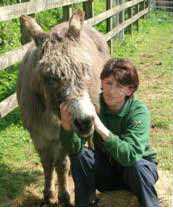
Donkeys requiring hospitalisation can be managed in a similar way to small ponies, although differences in temperament, behaviour and conformation must be taken into consideration.
Donkeys form strong bonds with companions and should be kept together. Stress should be kept to a minimum, as hyperlipaemia is a common complication of any management change or illness. Nurses and grooms should be sensitive to subtle behavioural changes, which are often early indicators of illness. Donkeys are stoical by nature and often do not exhibit dramatic symptoms. Any donkey described as dull, head held low, generally disinterested and with reduced appetite, should be investigated.
Stabling
Bonded animals should be kept together, and it should be ensured that the box or stable is large enough for two, or possibly three, donkeys. If it is necessary to separate them, ensure that they can see one another.
If the stable door is too high for the donkey to see over, use a hurdle or gate in the doorway. Ideally there should be access to an exercise yard, unless box-rest is indicated. Ensure that the stable has good ventilation, and use rugs and heat lamps to provide extra warmth if necessary. Use of dustfree bedding is preferred. Paper or cardboard is ideal and has the advantage that the hospitalised donkey is less likely to eat it compared to straw.
Make sure that stable fittings are a suitable height for donkeys. Bear in mind that they may not be used to automatic drinkers and can be frightened by the noise of re-filling. It is often better to use buckets as fluid intake can be monitored.
Hospitalisation
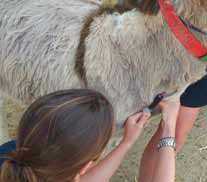
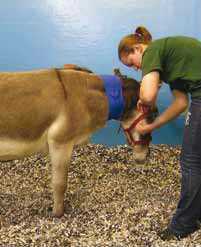
On arrival, assess the donkey’s age, condition score and any apparent problems. Donkeys often have unusual or individual preferences, so establish from the owner the normal feed and routine, as well as any likes or dislikes. Check if the donkey is on any medication, and the current vaccination and worming status.
If possible, weigh the donkey or use a heart girth/height chart to calculate its weight. When the donkey has settled, take a blood sample for routine haematology and biochemistry. This is particularly important if the donkey is admitted for surgery or is thin or elderly. After clotting, the serum should look clear, not cloudy or milky (which can indicate hyperlipaemia), nor yellow as in the horse. Thin and old donkeys should also have their teeth examined using a Hausmann’s gag. Dental problems such as loose teeth, steps and shear mouths are common.
Every day check the donkey’s general demeanour, appetite and the quantity and consistency of droppings. If in doubt, monitor ‘gut sounds’ by auscultation. Rectal examination is indicated if there is any suspicion of reduced gut activity.
Check digital pulses, as they can indicate the start of laminitis, and monitor vital signs:
- Respiration rate is best taken before entering the stable and disturbing the donkey. Also note any respiratory noise, increased respiratory effort or nasal discharge
- The pulse is taken from the submandibular artery where it crosses the mandible. It may be necessary to clip the jaw of a donkey with a thick coat.
- Ensure the donkey is well restrained before taking its temperature and stand close to the hindquarters to avoid being kicked. The normal temperature is 36.2°C to 37.8°C (97.2°F to 100°F)
Feeding
Age, condition score and dentition must be taken into consideration. Young and healthy adult animals do well on a high-fibre diet of hay and good quality barley straw and will probably not require concentrates. Hay is best fed from the floor, especially for animals suffering respiratory or eye problems. If possible, turn out to graze for part of the day or walk in hand, allowing the donkey to browse in hedgerows. If the donkey is unable to go out, feed succulents such as freshly cut grass, carrots and apples.
Many older donkeys have poor dentition and find it difficult to eat long fibre. Chaff-type feeds may need to be fed instead of hay, plus additional concentrates. Feeds should be dampened as these animals may be prone to choking.
Provide tempting feeds for a sick donkey, because it can often lose its appetite. Separate or tie up companions when the patient is offered a feed. Some donkeys will not eat whilst being watched; they can appear to be eating, but are just standing with their head lowered in the bucket. An anorexic donkey should be tempted with anything it will eat. Hand-feed and try bread, carrots, apples or biscuits. Owners should be consulted about favourite treats. Uneaten feed should be removed from the stable as it will become unappetising.
It is beneficial to spend time with the donkey, grooming, petting and hand-feeding, particularly if it is a much loved pet used to ‘one-to-one’ attention.
Handling and restraint
Well handled donkeys should be easy to catch. If this is not the case, follow the donkey into a corner and approach quietly from behind. It should be possible to put an arm over the donkey’s neck and fit a head collar. Unlike horses, donkeys are not flight animals, and tend to stand still when unsure of a situation.
Donkeys respond well to calm, confident handling. Use a well fitting head collar and tie ring, and feed treats to distract attention. It may be necessary to hold an ear, but twisting it is not acceptable. Rope twitches applied to the lip seem to have little effect on donkeys. However, they can be useful for mules, which can be difficult to handle.
Holding up a front leg can be useful, but beware, donkeys are adept at kicking whilst standing on three legs!
Drug administration
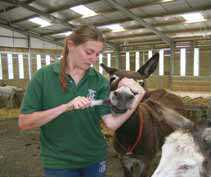
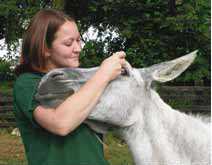
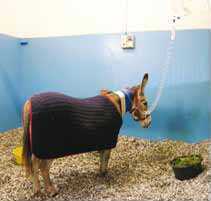
Oral drugs can be given in small feeds or mixed with treacle, fruit juice or jam and given in bread or biscuits. This is the best option for longterm drugs, which then become an anticipated treat. If the donkey will not take the drug, mix with water or juice and drench using a catheter tip syringe.
Intramuscular injections are given in the neck or rump using an 18 g x 1½ inch(1.2 x 40 mm) needle. Use 19 g or 21 g x 1 inch (0.8 x 25 mm) needles for foals and very small donkeys. Rotate sites to avoid muscle soreness. The brisket should not be used, as donkeys have narrow chests and very little muscle here.
The jugular vein is used for intravenous injections and blood sampling using an 18 g x 1½ inch (1.2 x 40 mm) needle. An assistant should hold the donkey with its head extended and turned slightly away from you. Make sure the area is clipped. It can be difficult to see the vein in very fat donkeys and stallions with well muscled necks. Be aware that it is relatively easy to mistakenly hit the carotid artery especially in very thin donkeys.
Subcutaneous injections are given under a pinch of skin in front of the shoulder.
Intravenous fluids are given through a 14 g catheter. Donkeys have short necks and 80 mm is usually the maximum length they will accommodate.
General anaesthesia nursing care
Castration
Donkey stallions need firm, confident handling. They can be very strong and may require a bit in the mouth when being led. Be aware that they may bite!
The stable door should be high enough so that they cannot see over or attempt to jump it. Some stallions can become very excited by the sight of other equines.
Castration is generally performed under general anaesthetic.
Post-operatively the bed should be kept as clean as possible to help avoid infection. The donkey should receive daily exercise to help prevent and reduce swelling. If he leads well and is not too strong he can be exercised in hand.
If he is turned out, ensure the field is well fenced and there are no other equines in sight. Vigorous exercise the day after surgery should be avoided as it may promote haemorrhage.
References
- Dabinett, S. (2008) Nursing care In Svendsen, E.D., Duncan, J. and Hadrill, D. (2008) The Professional Handbook of the Donkey, 4th edition, Whittet Books, Chapter 18
Hyperlipaemia
Hyperlipaemia is a common complication of any stress, management change or illness. Early detection and treatment are essential as, in the latter stages, mortality rates are high. Obese animals are at higher risk, but any donkey can be affected.
The early signs are subtle behavioural changes, appearing slightly dull and with a reduced appetite. A blood sample should be taken immediately. Milky serum is an indicator of the condition, which will be confirmed by raised triglyceride levels on laboratory analysis.
The treatment consists of supportive therapy, drenching or stomachtubing, as well as the administration of intravenous fluids, depending on the severity of the attack. Antibiotics, NSAIDs and drugs to prevent gastric ulcers are usually given.
Keep the donkey eating, hand-feed it and consult the owners with regard to its favourite treats. Turn the donkey out for gentle exercise at grass, or walk in hand, allowing it to browse in the hedgerow. Groom and spend time with the donkey. Early detection and good nursing are important for a successful outcome.
References
- Dabinett, S. (2008) Nursing care In Svendsen, E.D., Duncan, J. and Hadrill, D. (2008) The Professional Handbook of the Donkey, 4th edition, Whittet Books, Chapter 18
Colic
Donkeys do not usually display the classic signs of colic seen in horses. Early signs are a reduced appetite and a dull appearance. Diagnosis is confirmed by rectal examination, listening to gut sounds and an elevated pulse.
Provide the donkey with a deep bed, as it may go down and start rolling if its condition deteriorates. Companions should be separated, but kept in sight. The patient can then be left on intravenous fluids, with faecal output and food intake monitored. It may be necessary to withhold food.
Colonic impaction is a common cause of colic in donkeys associated with dental problems, diet changes and hyperlipaemia.
References
- Dabinett, S. (2008) Nursing care In Svendsen, E.D., Duncan, J. and Hadrill, D. (2008) The Professional Handbook of the Donkey, 4th edition, Whittet Books, Chapter 18
Laminitis
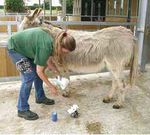
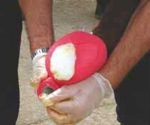
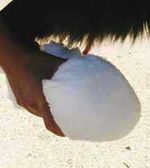
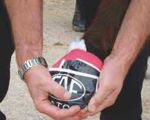
Donkeys, like ponies, are susceptible to laminitis. All four feet can be affected, but it is more common in the front feet. Obesity and a high carbohydrate diet are the most common risk factors, obese animals being at the highest risk. Other causes include trauma to the foot, weight-bearing if the other limb is injured, long or badly trimmed feet, hyperlipaemia, toxaemia and colic.
Laminitis is a painful condition. Clinical signs include strong digital pulses, lameness, weight shifting, a laminitic stance, reluctance to move, lying down and reluctance to stand, elevated pulse and sweating. Donkeys will also hold alternate forelimbs high above the ground, a stance not exhibited by horses.
Due to a donkey’s stoical nature, mild cases of laminitis can go unnoticed, particularly if the animal receives no exercise. It is important to check the digital pulses of hospitalised donkeys so that early treatment can be instigated.
Provide box-rest on a deep, inedible bed of paper or shavings so that the diet can be controlled. Ensure that water and food are within easy reach as it can be too painful for some animals to make the effort to move.
Foot pads provide some relief to the donkey. Pick out the feet and pad with a thick layer of cotton wool, bandage in place with a cohesive bandage. Adhesive patches designed for big bale silage (e.g. JAF-Patch, available from agricultural suppliers) can be applied to the bandage to make the dressings more waterproof. Sugardine paste, which is made from granulated sugar mixed with povidone-iodine antiseptic solution, can be applied to the sole beneath the cotton wool. This helps keep the foot clean, hardens soft soles and helps control infection.
Change foot dressings daily and check the sole for bruising and infection. If the donkey spends long periods lying down, check for pressure sores, particularly on elbows and stifles.
References
- Dabinett, S. (2008) Nursing care In Svendsen, E.D., Duncan, J. and Hadrill, D. (2008) The Professional Handbook of the Donkey, 4th edition, Whittet Books, Chapter 18
Euthanasia
References
- Dabinett, S. (2008) Nursing care In Svendsen, E.D., Duncan, J. and Hadrill, D. (2008) The Professional Handbook of the Donkey, 4th edition, Whittet Books, Chapter 18
|
|